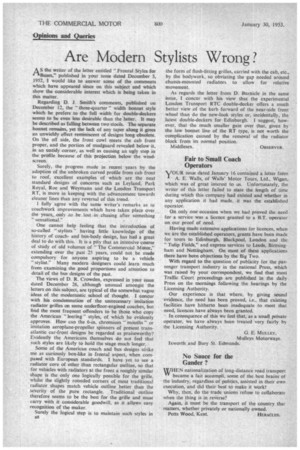Are Modern Stylists Wrong?
Page 118

If you've noticed an error in this article please click here to report it so we can fix it.
AS the writer of the letter entitled "Frontal Styles for Buses," published in your issue dated December 5, 1952, 1 would like to answer some of the comments which have appeared since on this subject and which show the considerable interest which is being taken in this matter.
Regarding D. J. Smith's comments, published on December 12, the 'three-quarter" width bonnet style which he prefers to the full width for double-deckers seems to be even less desirable than the latter. It may be described as falling between two stools. The separate bonnet remains, yet the lack of any taper along it gives an unwieldy effect reminiscent of designs long obsolete. On the oil side, the front cowl meets the cab front proper, and the portion of mudguard revealed below it, in an untidy corner, as well as causing an ugly step in the profile because of this projection below the windscreen.
Surely, the progress made in recent years by the adoption of the unbroken curved profile from cab front to roof, excellent examples of which are the neat standard designs of concerns such as Leyland, Park Royal, Roe and Weymann and the London Transport RT, is more in keeping with the advancement towards cleaner lines than any reversal of this trend.
I fully agree with the same writer's remarks as to coachwork improvements which have taken place over the years,, only to be lost in chasing after something sensational"
One cannot help feeling that the introduction of so-called " stylists " having little knowledge of the history of coachand bus-body design, has had a great deal to do with this. It is a pity that an intensive course of study of old volumes of "The Commercial Motor.extending over the past 25 years, could not be made compulsory for anyone aspiring to be a vehicle " stylist." Many modern designers could learn much from examining the good proportions and attention to detail of the bus designs of the past.
The views of D. R. Crowden, expressed in your issue dated December 26, although unusual amongst the letters on this subject, are typical of the somewhat vague ideas of the modernistic school of thought. I concur with his condemnation of the unnecessary imitation radiator grilles on some underfloor-engined coaches, but find the most frequent offenders to be those who copy the American " leering " styles, of which he evidently approves. How can the 6-in. chromium " mouths" or imitation aeroplane-propeller spinners of present transatlantic car-front designs be regarded as praiseworthy? Evidently the Americans themselves do not feel that such styles are likely to hold the stage much longer; Some of the American coach and bus designs strike me as curiously box-like in frontal aspect, when compared with European standards. I have yet to see a radiator core of other than rectangular outline, so that for vehicles with radiators at the front a roughly similar shape is the only one logically possible for the grille, whilst the slightly rounded corners of most traditional radiator shapes match vehicle outline better than the severity of the pure rectangle. Traditional outline therefore seems to be the best for the grille and must carry with it considerable goodwill, as it allows easy recognition of the maker.
Surely the logical step is to maintain such styles in aS the form of flush-fitting grilles, carried with the cab, etc., by the bodywork, so obviating the gap needed around chassis-mounted radiators to allow for relative movement.
As regards the letter from D. Burnicle in the same issue, I concur with his view that the experimental London Transport RTC double-decker offers a much better view of the kerb forward of the near-side front wheel than do the new-look styles or, incidentally, the latest double-deckers for Edinburgh. I suggest, however, that the much smaller gain over that, given by the low bonnet fine of the RT type, is not worth the complication caused by the removal of the radiator block from its normal position.
Middlesex. Oaseavea.
























































































































































